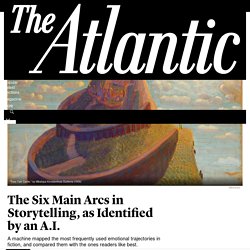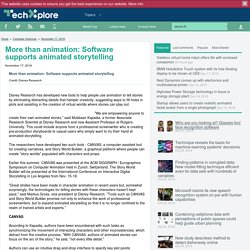

The Art and Science of Fairy Tales - Xenius. The Six Main Stories, As Identified by a Computer - The Atlantic. “My prettiest contribution to my culture,” the writer Kurt Vonnegut mused in his 1981 autobiography Palm Sunday, “was a master’s thesis in anthropology which was rejected by the University of Chicago a long time ago.”

By then, he said, the thesis had long since vanished. (“It was rejected because it was so simple and looked like too much fun,” Vonnegut explained.) But he continued to carry the idea with him for many years after that, and spoke publicly about it more than once. It was, essentially, this: “There is no reason why the simple shapes of stories can’t be fed into computers. They are beautiful shapes.” That explanation comes from a lecture he gave, and which you can still watch on YouTube, that involves Vonnegut mapping the narrative arc of popular storylines along a simple graph. The most interesting shape to him, it turned out, was the one that reflected the tale of Cinderella, of all stories. 1. 2. 3. 4. 5. 6. First, the researchers had to find a workable dataset. 48 Hours of Joseph Campbell Lectures Free Online: The Power of Myth & Storytelling.
Photo by "Folkstory" features Joseph Campbell (left) with Jonathan Young, via Wikimedia Commons.

You may not be interested in politics, they say, but politics is interested in you. The same, if you believe famed mythologist Joseph Campbell, goes for myth: far from explaining only the origin of the world as believed by extinct societies, it can explain the power of stories we enjoy today — up to and including Star Wars.
The man behind PBS' well-known series The Power of Myth left behind many words in many formats telling us precisely why, and now you can hear a fair few of them -- 48 hours worth -- for free on this Spotify playlist. (If you don't have Spotify's software already, you can download it free here.) "From the Star Wars trilogy to the Grateful Dead," says the Joseph Campbell Foundation, "Joseph Campbell has had a profound impact on our culture, our beliefs, and the way we view ourselves and the world. " Would you like to support the mission of Open Culture?
Related Content: More than animation: Software supports animated storytelling. Disney Research has developed new tools to help people use animation to tell stories by eliminating distracting details that hamper creativity, suggesting ways to fill holes in plots and assisting in the creation of virtual worlds where stories can play out.

"We are empowering anyone to create their own animated stories," said Mubbasir Kapadia, a former Associate Research Scientist at Disney Research and now Assistant Professor at Rutgers University. This could include anyone from a professional screenwriter who is creating pre-production storyboards to casual users who simply want to try their hand at animated storytelling. The researchers have developed two such tools - CANVAS, a computer-assisted tool for creating narratives, and Story World Builder, a graphical platform where people can create "story worlds" populated with characters and props.
Earlier this summer, CANVAS was presented at the ACM SIGGRAPH / Eurographics Symposium on Computer Animation held in Zurich, Switzerland. Fiction books narratives down to six emotional story lines. Our most beloved works of fiction hide well-trodden narratives.

And most fictions is based on far fewer storylines than many have imagined. To come to this conclusion, big data scientists have worked with colleagues from natural language processing to analyse the narrative in more than 1000 works of fiction. By deconstructing some of the structure of narrative in fiction books, they have also confirmed that there are six common ways of telling a story that can be found repeatedly in popular stories. They were inspired by the work of U.S. fiction author Kurt Vonnegut, who originally proposed the similarity of emotional story lines in a Masters's thesis rejected by the University of Chicago. These findings have just been published in EPJ Data Science by Andrew Reagan from the University of Vermont, USA, and colleagues. Reagan and colleagues thus determined that there were six main emotional storylines.
More information: Andrew J Reagan et al. Provided by Inderscience Publishers.